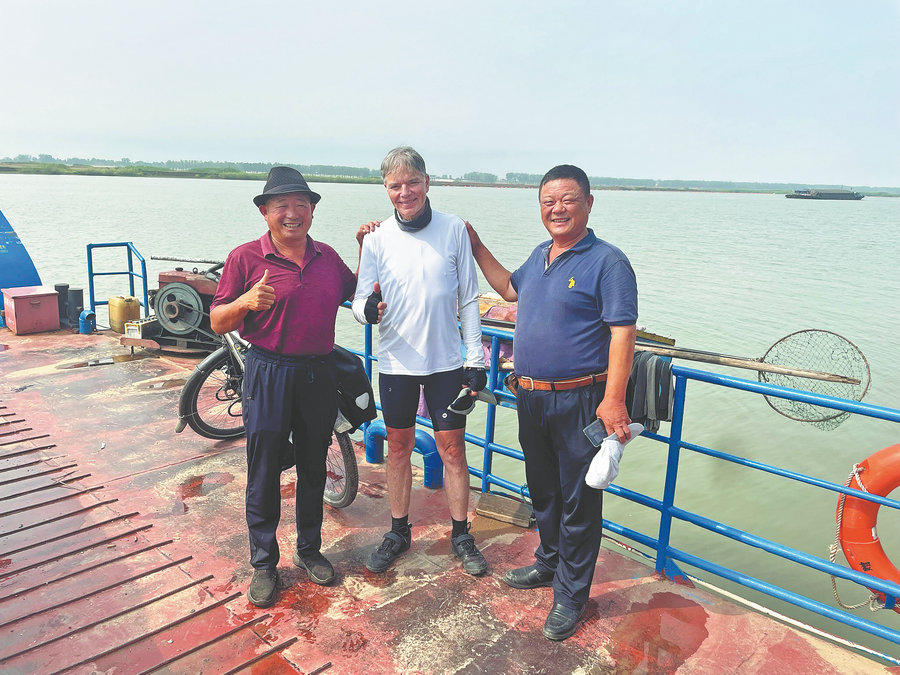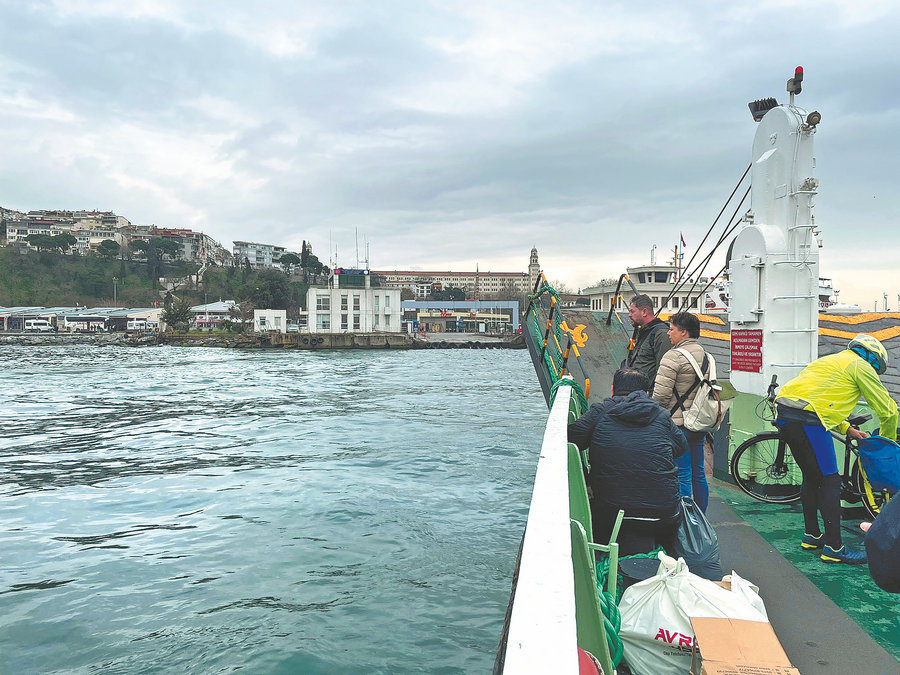Architect's cycling journey spins his intellectual wheel
While it normally takes over 10 hours to fly from Amsterdam to Shanghai, if you've ever wondered how long the trip would take by bicycle, Ole Bouman has the answer — 156 days.
Born in 1960 in Amersfoort, Netherlands, Bouman is a Dutch-German historian, writer, publisher, photographer, curator, lecturer and practitioner of design and architecture, and now a professor at the College of Architecture and Urban Planning at Tongji University in Shanghai.
Departing from Amsterdam in early February, Bouman cycled 10,756 kilometers through 18 countries and regions, as well as more than 500 historical sites, mapping an adventure filled with discoveries about people, cultures, stories, understanding and connection.
"From Amsterdam to Shanghai, the journey was never just about the distance. My bicycle became more than just a way to get from point A to point B; it was a companion, a tool, a way to dig into the world up close," writes Bouman in his blog, making a joke that he was just "commuting from home to work".
Motivated by curiosity
Bouman did not embark on this journey on a whim. It was a long-lingering idea that became clear and increasingly concrete over the last two years as he started making mental, physical, legal and financial preparations.
In addition to taking long daily walks and two-hour cycling trips to maintain his physical condition, Bouman points out that the most important preparation was to think of a "narrative" or "story "that would continuously motivate him to the finish line.
"I had the intellectual curiosity to learn more about the East since the 1990s. As a cultural historian, I would like to know more about the relationship and interconnection between the East and the West, so curiosity is my motivation," says Bouman.
Bouman has lived in China for around 10 years since he served as the creative director of the Urbanism and Architecture Bi-City Biennale of Shenzhen and Hong Kong in 2013. Before his teaching role at Tongji University, Bouman was the founding director of the Design Society, an initiative of China Merchants Group and the Victoria and Albert Museum, which opened in Shenzhen, Guangdong province, in December 2017.

"I think many people go from one world to another because of opportunity. The Design Society as a cultural platform was an unbelievable, high-speed project for me and one of my most exciting chapters. I caught this chance and felt so fascinated by the reason and the whole history behind it," says Bouman.
He further explains that he has always been interested in the background and context of things, which makes him want to better understand the deeper drive of his choice to live here. "It does not just mean to be dropped in the middle of Shenzhen or Shanghai but to experience what it takes to go step by step toward the East, to be slowly embraced by the East and to see how the journey would change my mindset. That was an important personal motivation."
On the road
A 45-kilogram bag and an 18-kg bicycle are all that carried Bouman on the long journey that crossed about 300 rivers, climbed over 100 mountains and traveled through three deserts and regions with 16 different languages.
Dedicating much of his professional life to architecture, Bouman has a broad definition of it, which makes him see the journey as a kind of design project. Normally, he would cycle 120 to 130 km in roughly seven hours per day.
"For many people, architecture is about designing a beautiful building or just making a building. But I think architecture is about the careful organization of space or spatial arrangement. Once you are very strong in spatial organization, you can apply it to a building but also to other things, including cultures, history, engineering, stories and values — even a long journey. I think an architect should learn about all these things, " says Bouman.
During the journey, Bouman continued teaching online once a week from one location, where he shared his observations along the road and discussed with students what he would see and experience the next week. Together, with his students, Bouman has designed an inspiring "architectural journey".
Every day, Bouman rode toward new horizons and different destinations. He tried to find a road that was smooth enough to make some progress, but not so smooth to gain new experiences. Such a journey has brought him many unexpected challenges and deeper thinking.
Among the many difficulties that he faced were heat, cold, headwinds, distance, mountains, floods, bad roads, nails and rocks on the pavement, wild animals, aggressive guards, and sometimes the necessary distrust to get out of a situation quickly, according to his blog.
A big challenge came in May when he ran into the extreme heat at the Flaming Mountains and the drought of the Gobi and Taklimakan deserts in Northwest China's Xinjiang Uygur autonomous region.
These unexpected encounters inspired Bouman to further explore a core argument during the journey, which he summarizes as "the clash between West and East, as well as the clash between modernity and nature, and how to overcome them".
Cycling from the West and capturing thousands of memorable moments, Bouman says he became more convinced that his journey was also about peace.

Designing a legacy
"From the West to the East, there are big changes in culture, landscape, literature, politics and so on. But while pursuing changes and interacting with ordinary people, I increasingly became aware of the common ground we share," says Bouman. "People are pursuing a similar kind of normal life and personal happiness. This common ground is the fabric of peace and is much more important than the differences. Going through the Christian world, the Muslim world, the Buddhist world and the Taoist world along the journey, I found different ways to pursue peace that are, in principle, similar."
"There is a symbiosis between architecture and peace. Architecture can be a strong torchbearer of peace, as its passing on to the next generation can only happen in peaceful situations. Otherwise, it might be destroyed," he adds.
Although Bouman's journey to the East has come to the finish line, the thinking, conversations and connections it sparked are just beginning. While continuing to share his thoughts and experiences with his students, Bouman would also like to advise those who followed his journey.
He encourages people searching for cycling experiences to go on a long tour, as it can bring them closer to truth and reality. For travelers, he advises them to pay respect to local customs and manners and to listen and observe more. For architects, his advice is to learn from the past, as the power of architecture is a sign of cultural heritage. For young people, he emphasizes the significance of seeing things by making physical efforts and cultivating their memories rather than absorbing ideas on computers.
For himself, Bouman aims to write a book about his journey, adding with a laugh that he hopes to complete a full circle of the "Journey to the West" one day.